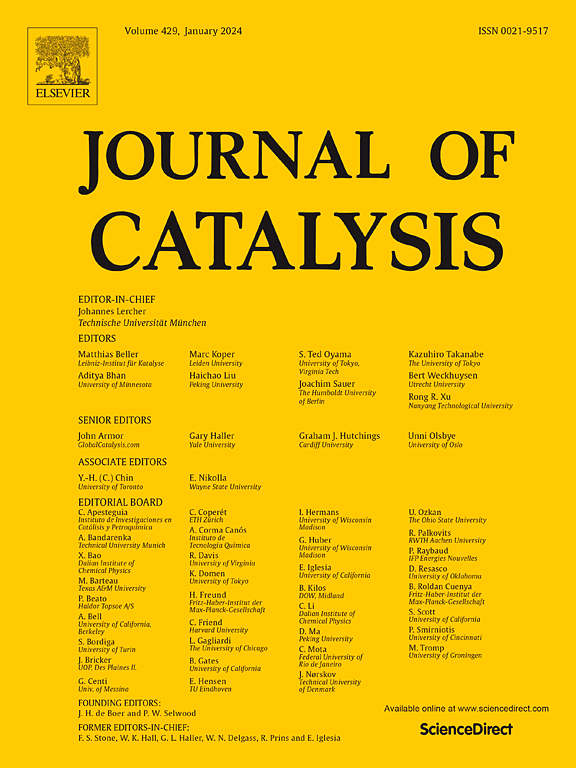Effect of zeolite framework on the NO operating cycle in Pd-based passive NOx adsorbers
IF 6.5
1区 化学
Q2 CHEMISTRY, PHYSICAL
引用次数: 0
Abstract
Density Functional Theory (DFT) simulations are performed to understand the impact of zeolite framework on the operating cycle of NO adsorption and desorption in Pd-based passive NOx adsorbers. The binding energy on all sites exhibits the trend: BEA > ZSM-5 > CHA, which is consistent with reported trends in the NOx desorption temperatures. Independent of the zeolite framework, NO binds strongly on Pd1+ site, whereas its binding on Pd(II) sites (Pd2+, [PdOH]+, dimeric Pd) is considerably weaker. However, the binding strength on Pd1+ and Pd2+ sites is similar in ZSM-5 and BEA. The free energy of activation for the reduction of Pd(II) species by NO is dependent on the zeolite framework. NO oxidation on [Pd-O-Pd]2+ has a low free energy barrier in ZSM-5 (29 kJ/mol) but exhibits the highest reaction barrier in CHA (77 kJ/mol). Further, the reoxidation of Pd1+ to [Pd-O-Pd]2+ is facile in Ferrierite (FER) but has a high free energy barrier in Chabazite (CHA). A kinetic model is developed for Pd/CHA and Pd/BEA which predicts a single desorption peak for CHA and two desorption peaks for BEA. The site-specific NO binding energy trends and the energetics of interconversion between sites result in differences in the NOx adsorption-desorption characteristics on different zeolite frameworks. The presence of H2O decreases the NO binding strength on all Pd sites except Pd2+ in FER and [PdOH]+ in CHA. CO preferentially reduces the Pd(II) species when both CO and NO are co-adsorbed on [PdOH]+[PdOH]+ with BEA exhibiting the lowest barrier.


沸石框架对钯基被动式氮氧化物吸附器中氮氧化物运行周期的影响
采用密度泛函理论(DFT)模拟了沸石骨架对pd基被动NOx吸附剂中NO吸附和解吸操作循环的影响。各位结合能均呈现如下趋势:BEA >;ZSM-5 >; CHA,这与报道的NOx脱附温度趋势一致。与沸石骨架无关,NO在Pd1+位点上的结合较强,而在Pd(II)位点(Pd2+, [PdOH]+,二聚体Pd)上的结合较弱。然而,ZSM-5和BEA在Pd1+和Pd2+位点上的结合强度相似。NO还原Pd(II)的自由活化能取决于分子筛结构。NO对[Pd-O-Pd]2+的氧化在ZSM-5中具有较低的自由能垒(29 kJ/mol),而在CHA中表现出最高的反应能垒(77 kJ/mol)。此外,Pd1+在铁素体(FER)中容易再氧化为[Pd-O-Pd]2+,而在恰巴石(CHA)中具有较高的自由能垒。建立了Pd/CHA和Pd/BEA的动力学模型,预测了CHA的单解吸峰和BEA的两个解吸峰。不同位置的NO结合能趋势和位点间相互转化的能量学导致了不同分子筛框架上NOx吸附-解吸特性的差异。H2O的存在降低了除FER中的Pd2+和CHA中的[PdOH]+外所有Pd位点上NO的结合强度。当CO和NO共同吸附在[PdOH]+[PdOH]+上时,CO优先还原Pd(II), BEA的势垒最低。
本文章由计算机程序翻译,如有差异,请以英文原文为准。
求助全文
约1分钟内获得全文
求助全文
来源期刊

Journal of Catalysis
工程技术-工程:化工
CiteScore
12.30
自引率
5.50%
发文量
447
审稿时长
31 days
期刊介绍:
The Journal of Catalysis publishes scholarly articles on both heterogeneous and homogeneous catalysis, covering a wide range of chemical transformations. These include various types of catalysis, such as those mediated by photons, plasmons, and electrons. The focus of the studies is to understand the relationship between catalytic function and the underlying chemical properties of surfaces and metal complexes.
The articles in the journal offer innovative concepts and explore the synthesis and kinetics of inorganic solids and homogeneous complexes. Furthermore, they discuss spectroscopic techniques for characterizing catalysts, investigate the interaction of probes and reacting species with catalysts, and employ theoretical methods.
The research presented in the journal should have direct relevance to the field of catalytic processes, addressing either fundamental aspects or applications of catalysis.
 求助内容:
求助内容: 应助结果提醒方式:
应助结果提醒方式:


